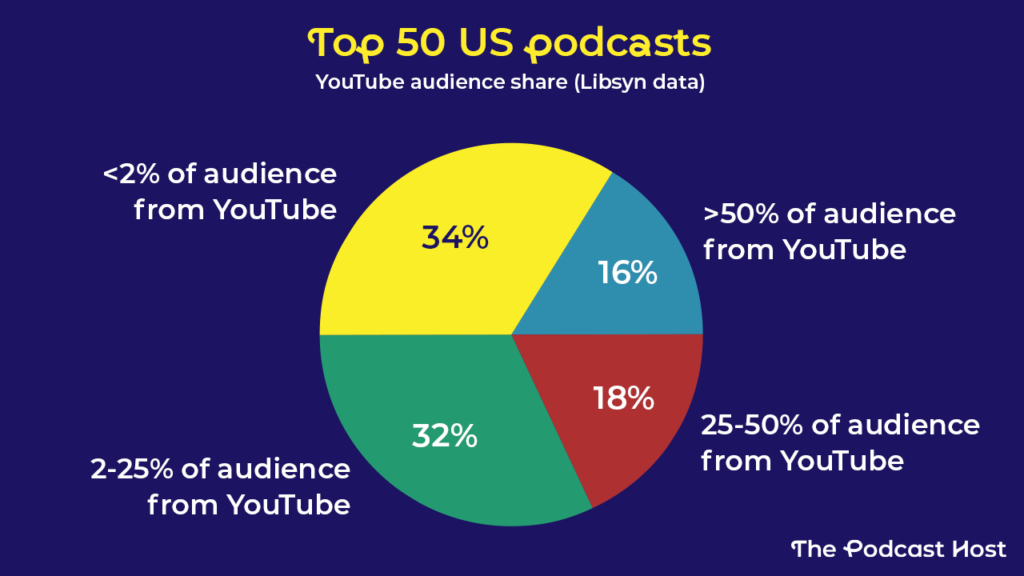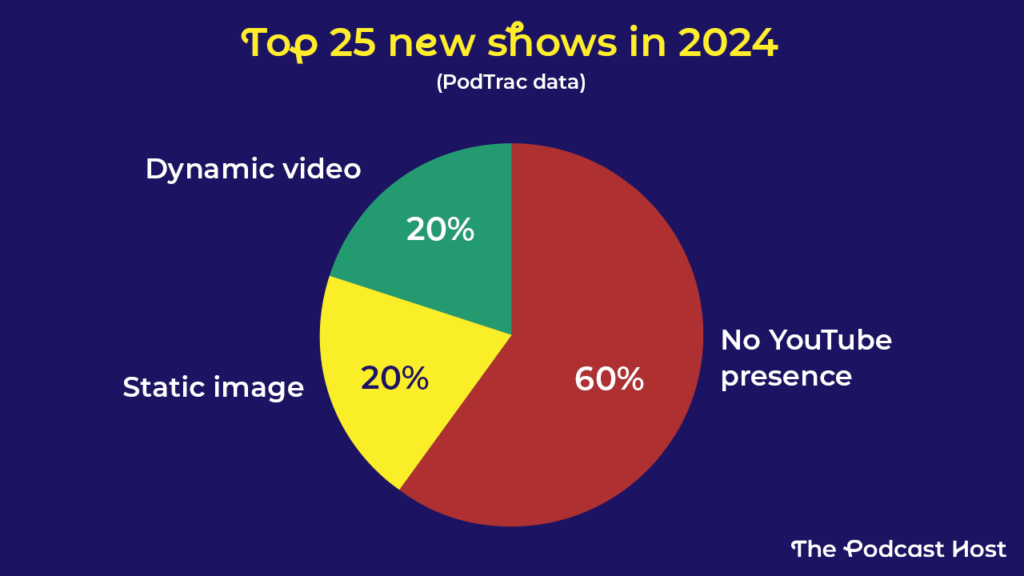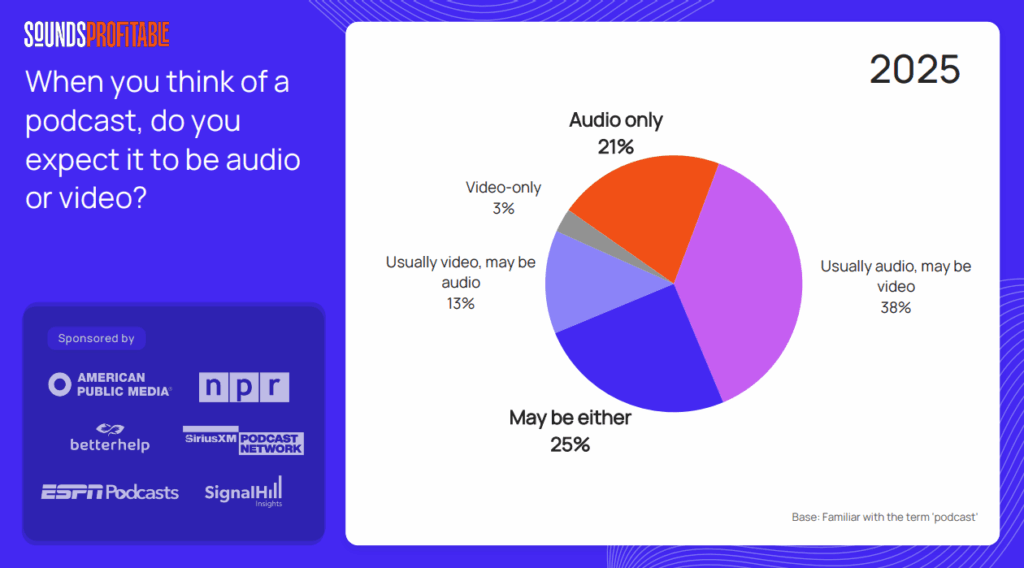The Truth About Audio-Only Podcasts in 2025: What the Data Says
Podcasting “is at an inflection point: Investigative deep dives are out, cheaper chitchat is in, and it’s got to be on video to break through.”
That is, at least, according to entertainment journalist James Hibberd in a recent piece for the Hollywood Reporter.
James is entitled to his opinion, of course. But exaggerated claims like this can mislead and harm the industry. Not only are they about as reliable as licking your finger to see what way the wind is blowing, but they also push creators to second-guess themselves or even stop making the work they enjoy.
Debates over video versus audio in podcasting have been loud this past year, but hard numbers have been scarce. Recently, however, Rob Walch of Libsyn and Tom Webster of Sounds Profitable shared data that challenges much of the narrative. Here are the key takeaways.
Dynamic Video is Only Essential at the Very Top Tier
In episode 300 of Libsyn’s podcast, The Feed, Rob did some data digging to test the Hollywood Reporter’s claim that a podcast has “got to be on video to break through.”
When looking at the top 50 shows on Libsyn, Rob learned that, in reality, dynamic video was only needed at the very (very!) top.
Yes, the shows reaching a 300k+ audience per episode required live-action video, but those between 50k and 300k saw no clear difference between having no video, static video, or dynamic video.
Remember, you only need about 27 downloads to put you in the top 50% of podcasts, so these are all elite-level numbers that most of us can only dream of. The real takeaway? Lessons from blockbuster shows don’t automatically translate to indie podcasters. What works at the very top doesn’t necessarily work for everyone else.
YouTube Is Just One Part of The Picture
YouTube is undeniably making its mark as a major new podcast consumption platform, but it’s still only one part of the picture.
Yes, YouTube consumption is growing, but one of the best aspects of RSS distribution is that listeners are free to choose from many different platforms to access podcasts.

And the data shows that people still do. Rob’s research showed the largest proportion of the top 50 podcasts still got less than 2% of their audience from YouTube, and only 16% got more than half of their audience from the platform.
Loads of the Top Podcasts Still Don’t Use Video
Of course, it’s undeniable that many of the top podcasts have a video component. But to suit the hype narrative, we often ignore a really important point: a huge amount of them don’t.
In Rob’s research, he also found that when looking at the top 25 new shows in just the last year on Podtrac, only 5 (20%) had video. The same amount used a static image when publishing to YouTube, and 60% (15/25) had no YouTube presence at all.

When we look back again at the top 50 US shows (which includes shows that didn’t just launch in 2024), the number of shows with dynamic video is higher, but not by as much as you might think.

While 66% of the top 50 shows have a video accompaniment, 24% just post audio with a static image to leverage the platform, and 10% of the top shows again have no YouTube presence at all.
Half of Those Who Consume Podcasts on YouTube Only Listen
Tom Webster from Sounds Profitable also recently presented some data from their Podcast Landscape Report.
They found that almost half of those listeners they surveyed who said they consume podcasts on YouTube only listen – they don’t watch – even when it’s a video podcast.
Here’s a point often missed in the video trend: if you produce video for podcasts, it also has to work in audio. It is not just about repurposing audio for video.
Last year, we ran a study that suggested YouTube’s growth as a platform for podcasts isn’t synonymous with the rise of video podcasts, as a lot of people like to claim. In reality, it’s simply an indicator of the growth in popularity of YouTube more generally as a platform for watching OR listening. Sounds Profitable’s data paints a similar picture.
Audio-Heavy Deep Dives Remain Strong
Contrary to the Hollywood Reporter’s claim that ‘investigative deep dives are out,’ the numbers suggest otherwise.
18 out of 25 (72%) of the top new shows of 2024 were true crime or long-form investigations, according to Podtrac.
Interestingly, the claim isn’t supported in the article either. Beyond that opening sentence claiming investigative true crime was out of fashion, there’s nothing in the article to substantiate it.
Listeners Want Flexibility – But Not at the Expense of Your Show
A final takeaway from Sounds Profitable’s Podcasting Landscape report is a growth in public perception that a podcast may be either video or audio.

This means the real issue is not format but freedom. Listeners want the option to engage however they prefer, on the platforms they choose. If you can offer both video and audio, that is great. But never at the cost of being sustainable and consistent.
Can I Still Make an Audio-Only Podcast in 2025?
As James Cridland of Podnews puts it, a podcast works best when it gives the ears something to do while the eyes are busy. With that principle in place, your show can thrive on any platform, regardless of whether the audience is watching a screen.
Video will always remain an option for later. If and when you feel ready and capable, you can expand into it without forcing it too soon.
The Hollywood Reporter piece said that: “Breaking through as an independent act has never been tougher.” It’s a fair point. But chasing video content you do not want to make will not fix that. Focusing on the podcast you can sustain will.

